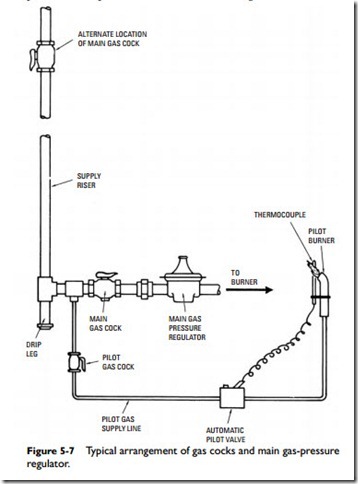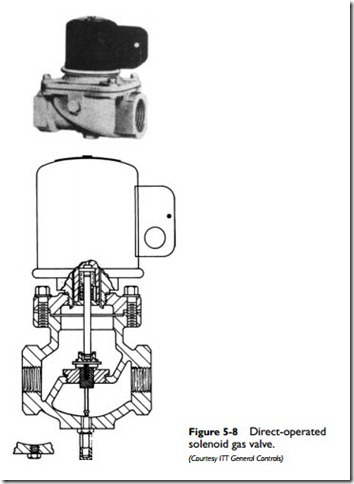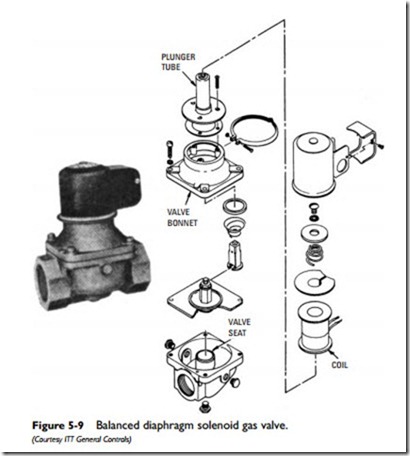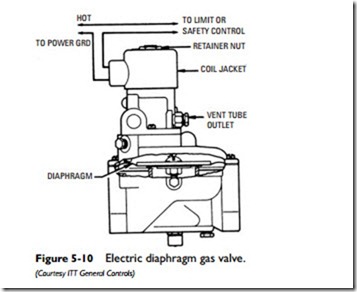Solenoid Gas Valves
The solenoid gas valve is commonly used on gas-fired heating equipment to provide on-off control of the flow of gas.
The primary function of a solenoid valve is to provide direct valve operation. The power to operate the valve is obtained from the magnetic flux developed in a solenoid coil. A valve disc in the valve body is connected by a rod to the core of an electromagnet. When the room thermostat or power switch directs an electrical current to the solenoid, it pulls the rod (plunger) to the top of the
plunger tube and lifts the attached valve disc. Gas then flows through the main valve port until the electrical circuit is interrupted by the controller. This action releases the rod, which falls and shuts off the valve. The weight of the rod and seat assembly and the gas pressure on top of the valve seat ensure a tight shutoff. The ITT
General Controls K3 Series gas valve shown in Figure 5-8 is an example of a direct-operated solenoid gas valve.
Some solenoid valves use a balanced diaphragm to control the flow of gas (see Figure 5-9). When the solenoid coil is energized, it lifts the rod or plunger just enough to open a bleed valve (or so- called pilot valve). Gas then bleeds from the area above the diaphragm faster than it can be replaced. This eventually results in the pressure above the diaphragm being the same as the pressure below the seat disc. This is referred to as a balanced or unloaded condition. The solenoid coil lifts the complete interior assembly to full open position. When the solenoid is deenergized, the pressure recovers above the diaphragm. The weight of the interior assembly and the gas pressure across the seat disc are sufficient to hold the valve closed. In this type of valve, the pressure of the gas is used to control its operation.
A third type of solenoid valve consists of a solenoid-operated (i.e., magnetically operated) puff bleed three-way valve and a diaphragm valve in a single unit (see Figure 5-10). The combined unit provides on-off control of the gas to the gas-fired heating equipment.
The three-way valve (also referred to as a pilot valve), respond- ing to electrical signals from the limit or safety controls, opens or closes the gas valve by controlling the gas pressure bleed-off above the diaphragm in the main valve body. In the normally closed position, inlet gas pressure above the diaphragm prevents the valve from opening. In the open (energized) position, the three-way or pilot valve closes off the inlet gas pressure and allows the gas pressure above the diaphragm to bleed off so that gas pressure below the diaphragm forces the diaphragm up to open the valve.
Dual-solenoid valves are designed for three-stage control (high- low-off) of the flow of gas (see Figure 5-11). Both a high-fire solenoid and a low-fire solenoid are used to accomplish this pur- pose. Low-fire adjustments can be made by turning the adjustment screw clockwise (to decrease low fire) or counterclockwise (to increase it).
Figure 5-12 shows a schematic wiring diagram of a two-stage control containing a dual-solenoid valve. If both solenoids are to be energized at one time, the circuit requires a 40-volt transformer.





